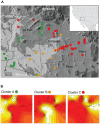Fuzzy boundaries: color and gene flow patterns among parapatric lineages of the western shovel-nosed snake and taxonomic implication
- PMID: 24848638
- PMCID: PMC4029750
- DOI: 10.1371/journal.pone.0097494
Fuzzy boundaries: color and gene flow patterns among parapatric lineages of the western shovel-nosed snake and taxonomic implication
Abstract
Accurate delineation of lineage diversity is increasingly important, as species distributions are becoming more reduced and threatened. During the last century, the subspecies category was often used to denote phenotypic variation within a species range and to provide a framework for understanding lineage differentiation, often considered incipient speciation. While this category has largely fallen into disuse, previously recognized subspecies often serve as important units for conservation policy and management when other information is lacking. In this study, we evaluated phenotypic subspecies hypotheses within shovel-nosed snakes on the basis of genetic data and considered how evolutionary processes such as gene flow influenced possible incongruence between phenotypic and genetic patterns. We used both traditional phylogenetic and Bayesian clustering analyses to infer range-wide genetic structure and spatially explicit analyses to detect possible boundary locations of lineage contact. Multilocus analyses supported three historically isolated groups with low to moderate levels of contemporary gene exchange. Genetic data did not support phenotypic subspecies as exclusive groups, and we detected patterns of discordance in areas where three subspecies are presumed to be in contact. Based on genetic and phenotypic evidence, we suggested that species-level diversity is underestimated in this group and we proposed that two species be recognized, Chionactis occipitalis and C. annulata. In addition, we recommend retention of two subspecific designations within C. annulata (C. a. annulata and C. a. klauberi) that reflect regional shifts in both genetic and phenotypic variation within the species. Our results highlight the difficultly in validating taxonomic boundaries within lineages that are evolving under a time-dependent, continuous process.
Conflict of interest statement
Figures





Similar articles
-
Phylogeography and species boundaries of the western North American Nightsnake (Hypsiglena torquata): revisiting the subspecies concept.Mol Phylogenet Evol. 2008 Mar;46(3):1095-115. doi: 10.1016/j.ympev.2007.12.012. Epub 2007 Dec 23. Mol Phylogenet Evol. 2008. PMID: 18226930
-
Complex evolution in the Neotropics: the origin and diversification of the widespread genus Leptodeira (Serpentes: Colubridae).Mol Phylogenet Evol. 2009 Dec;53(3):653-67. doi: 10.1016/j.ympev.2009.07.022. Epub 2009 Jul 28. Mol Phylogenet Evol. 2009. PMID: 19643196
-
Phylogenetics of Kingsnakes, Lampropeltis getula Complex (Serpentes: Colubridae), in Eastern North America.J Hered. 2017 May 1;108(3):226-238. doi: 10.1093/jhered/esw086. J Hered. 2017. PMID: 28119446
-
Phylogeographic analysis and environmental niche modeling of the plain-bellied watersnake (Nerodia erythrogaster) reveals low levels of genetic and ecological differentiation.Mol Phylogenet Evol. 2010 Jun;55(3):985-95. doi: 10.1016/j.ympev.2010.03.012. Epub 2010 Mar 17. Mol Phylogenet Evol. 2010. PMID: 20302955 Free PMC article.
-
Empirical and philosophical problems with the subspecies rank.Ecol Evol. 2022 Jul 10;12(7):e9069. doi: 10.1002/ece3.9069. eCollection 2022 Jul. Ecol Evol. 2022. PMID: 35845367 Free PMC article. Review.
Cited by
-
A conservation checklist of the amphibians and reptiles of Sonora, Mexico, with updated species lists.Zookeys. 2019 Mar 11;829:131-160. doi: 10.3897/zookeys.829.32146. eCollection 2019. Zookeys. 2019. PMID: 30914839 Free PMC article.
-
Testing Taxon Tenacity of Tortoises: evidence for a geographical selection gradient at a secondary contact zone.Ecol Evol. 2015 May;5(10):2095-114. doi: 10.1002/ece3.1500. Epub 2015 Apr 30. Ecol Evol. 2015. PMID: 26045959 Free PMC article.
-
The eastern migratory caribou: the role of genetic introgression in ecotype evolution.R Soc Open Sci. 2016 Feb 3;3(2):150469. doi: 10.1098/rsos.150469. eCollection 2016 Feb. R Soc Open Sci. 2016. PMID: 26998320 Free PMC article.
-
Genetic boundary and gene flow between 2 parapatric subspecies of brown rats.Curr Zool. 2020 Dec;66(6):677-688. doi: 10.1093/cz/zoaa027. Epub 2020 Jun 9. Curr Zool. 2020. PMID: 33391367 Free PMC article.
References
-
- de Queiroz K (1998) The general lineage concept of species, species criteria, and the process of speciation. In: Howard DJ, Berlocher SH, editors. Endless Forms: Species and Speciation. Oxford, MA: Oxford University Press. pp. 57–75.
-
- Cracraft J (1983) Species concepts and speciation analysis. In: Johnston R, editor. Current Ornithology: Springer US. pp. 159–187.
-
- Mayr E (1942) Systematics and the origin of species. New York: Columbia University Press.
Publication types
MeSH terms
Substances
LinkOut - more resources
Full Text Sources
Other Literature Sources

